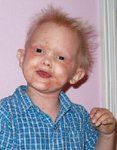- Acne
- Actinic Keratosis
- Aesthetics
- Alopecia
- Atopic Dermatitis
- Buy-and-Bill
- COVID-19
- Case-Based Roundtable
- Chronic Hand Eczema
- Chronic Spontaneous Urticaria
- Drug Watch
- Eczema
- General Dermatology
- Hidradenitis Suppurativa
- Melasma
- NP and PA
- Pediatric Dermatology
- Pigmentary Disorders
- Practice Management
- Precision Medicine and Biologics
- Prurigo Nodularis
- Psoriasis
- Psoriatic Arthritis
- Rare Disease
- Rosacea
- Skin Cancer
- Vitiligo
- Wound Care
Article
Potential treatment would address hypohidrotic ectodermal dysplasia
A novel potential treatment is on the horizon for hypohidrotic ectodermal dysplasia (HED), according to the director of research at a patient advocacy foundation.

Key Points

"One of the most exciting developments in the current state of research for therapy is a new novel approach called EDI200," says Mary Fete, R.N., M.S.N., C.C.M., director of research, National Foundation for Ectodermal Dysplasias (NFED).
The therapy is a form of ectodysplasin-A1 (EDA-A1) being developed by Edimer Pharmaceuticals as a treatment for certain patients with X-linked hypohidrotic ectodermal dysplasia (XLHED). EDI200 is produced by using recombinant DNA technology.
HED results in the abnormal development of structures including the skin, hair, nails, teeth and sweat glands. The condition is characterized by hypotrichosis, hypohidrosis and hypodontia. Physical growth and psychomotor development are otherwise within normal limits.
HED is the most common form of ectodermal dysplasia in humans, affecting approximately one in 17,000 people worldwide.
Managing HED includes optimizing psychosocial development, establishing optimal oral function and preventing hyperthermia. Dermatologic concerns include eczema, rashes and dry skin associated with certain outdoor exposures.
Potential therapy

"This protein is missing in patients with X-linked HED," Ms. Fete says.
Researchers in Lausanne, Switzerland, first developed a synthetic version of EDA-A1 that has shown promising results in animals with a disease similar to XLHED, she says.
"This research has led to the development of EDI200. The rationale for the use of EDI200 in XLHED patients is based on the lack of functional EDA-A1 protein in these patients, which affects the formation of ectodermal structures," she says. "EDI200 has been shown to substitute for this protein during development in mice and dogs."
Edimer plans to conduct clinical trials at the end of 2011, Ms. Fete says.
"The NFED is excited about EDI200 as a potential therapy for individuals affected by XLHED," she says. "This novel therapy offers hope for treatment of the symptoms. As with any research that is in the beginning phases, we are cautiously optimistic that this therapy will be successful in treating the manifestations of the condition."
Recent research
A recent study systematically studied the three disease-causing genes for both autosomal dominant and recessive forms on hypohidrotic and anhidrotic ectodermal dysplasia (HED/EDA): EDA1 accounting for X-linked forms; EDAR; and EDARADD. Also analyzed was the WNT10A gene, the gene identified as responsible for various autosomal recessive forms of ectodermal dysplasias, including onycho-odonto-dermal dysplasia and Schöpf-Schulz-Passarge syndrome.
The study included a cohort of 65 unrelated patients, of which 61 presented with HED/EDA. The four genes accounted for 92 percent of HED/EDA cases, with the EDA1 gene the most common disease-causing gene (58 percent of cases). WNT10A and EDAR were each responsible for 16 percent of cases.
"Although no clinical differences between patients carrying EDA1, EDAR or EDARADD mutations could be identified, patients harboring WNT10A mutations displayed distinctive clinical features (marked dental phenotype, no facial dysmorphism), helping to decide which gene should be first investigated in HED/EDA," the researchers reported.
Early detection
A recent Austrian cross-sectional postal survey among parents of 100 children with ectodermal dysplasia looked at the prevalence and prevention of severe complications of HED in infancy. The study aimed to re-evaluate the mortality of HED and the prevalence of hyperpyrexia and possible neurological sequelae in affected infants.
The researchers concluded that the mortality of HED and the risk of hyperthermic brain damage are still increased, but lower than reported previously. They also noted that the individual's prognosis depended on the type of genetic defect and the time point of diagnosis. Early recognition of the disease was aided by neonatal care and consulting a dermatologist or geneticist, according to the study. Adequate instruction to parents and networking with patient support groups also reduced the risks associated with HED.
Ms. Fete says the recent developments concerning EDI200 and other research is critical.
"It is really important to get this information out to doctors about potential treatments and therapies, so they can be aware of it for their patients, because early diagnosis is crucial for treatments," she says.
Newsletter
Like what you’re reading? Subscribe to Dermatology Times for weekly updates on therapies, innovations, and real-world practice tips.
















